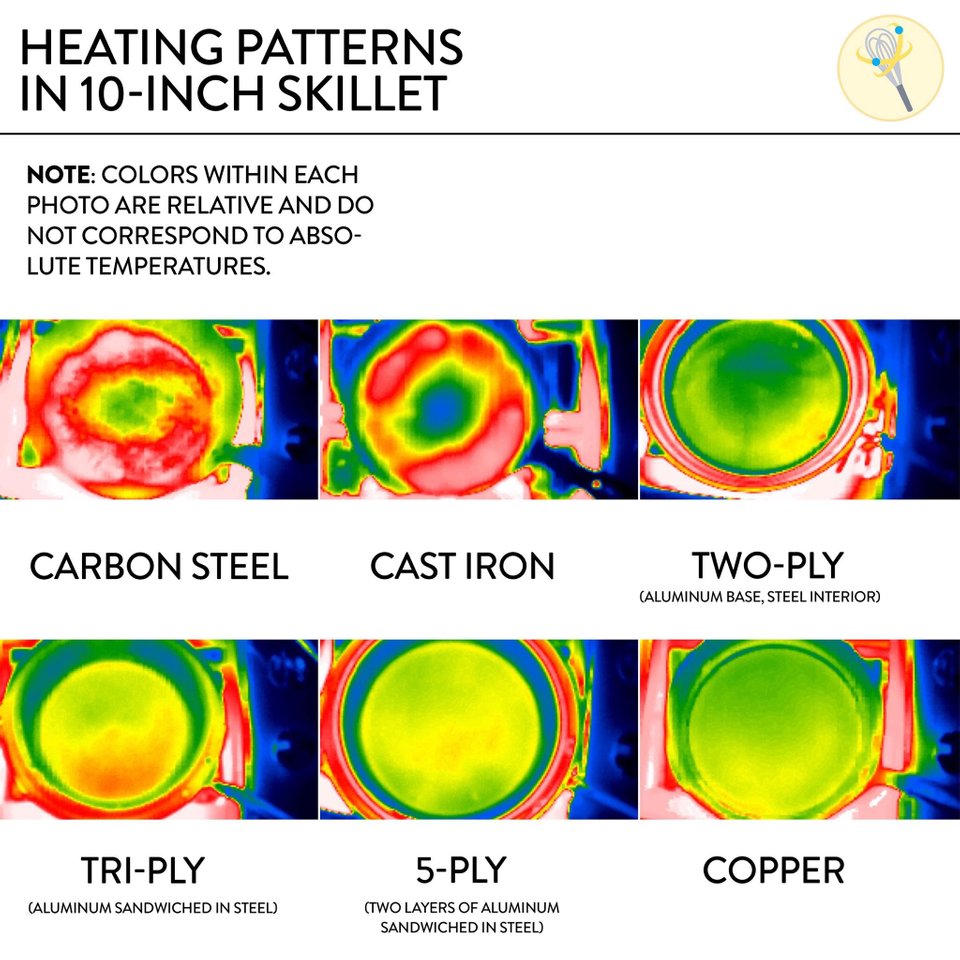Not just a passing trend, stainless-steel cookware has become mainstream in contemporary cookware for very good reasons and can keep these condition for years. However, before shopping for this cookware, there are many different factors to take into consideration.
These are all pros and cons you should know before buying:
Advantages
- Very Durable. Stainless-steel comes close to indestructible. Forget about the annoying problems of chip coat like nonstick, stain like enameled or rust like cast-iron cookware. The more quality stainless-steel (we mean multi-ply construction), the more hardness of the surface. The good stainless-steel tools will last for long or even can be passed to the next generation.
-
Good Cooking Ability. Multi-ply stainless-steel has excellent cooking performance — quick heat absorption and evenly heat.
See the heating pattern experimental tested by Kenji Lopez-Alt, a food expert and chef from Serious Eats, that gives a rough idea of the temperature range the pans achieve. He took the photo with Seek thermal imaging camera after heating each pan over high heat on a gas burner for 90 seconds. In these photos, white is 500°F, pink is 400°F and anything below 400°F is black.
Source: Reddit
At least, this can tell how good of the multi-ply cookware are. The 5-ply pan comes close to the copper pan, which did very exceptional jobs for evenly heating.
- Easy to Clean. With smooth, non-porous and hard surface, stainless cookware is very easy to clean. It allows to scrub (but rough sponges can leave scratchy marks), soak and clean with hassle-free, or can be thrown in the dishwasher machine (but can lessen the polish surface) if you’re too lazy to handwash.
- Low Maintenance. Simple care is needed. You don’t have to season to prevent rust or pamper the fragile coat to stop peeling. In fact, it has no special techniques for caring and cleaning, just need the right solution when occasionally has badly scorches. If this happens, see how to deal with badly burnt foods issues and all done.
- No Food-Reactive. This is one of the safe products for acid foods. It allows cooking acidic recipes, like tomato sauces or cilantro lime fish, without the risk of leaching any harmful chemicals or a wired taste like some other bare metals. However, for safety concerns, see the safety of stainless.
- Good Weight. The weight is comfort to maneuver. Comparing to hefty 7 pounds (with no foods) of a 12” cast-iron pan, a tri-ply skillet, at around 3 pounds, is much lighter while also excels for searing steaks without burdening your wrist.
- Polish-y Attractive Appearance. Shiny, mirror-finished and sturdy-feeling pots and pans always fit every decoration — from modern loft, traditional style, to urban country. Plus, most of them accents beautiful, chef-styled design that makes a feel cook-like-a-pro experience.
- Reasonable Price. It offers wide price ranges, from budget to high-end. Also, buying stainless-steel cookware is a wise investment as less expensive, comparing to other products at the same performance.
Disadvantages
-
Poor Heat Distribution, unless having bonded conductor(s). The multi-ply cookware offers superb ability, but non-conductive type is very poor. Stainless-steel itself is bad conductor — slowly and unevenly temperature changes and needs conductive materials to boost the performance.
To buy, the best choice is multi-ply or clad from bottom to rims construction. The second is product that putting a heat-transferred material in the bottom or bottom disc. While non-conductor cookware is NOT recommended because of poor performance and durability. That’s why most experts recommend buying quality cookware.
- Food Sticks. This is the most classic issue to stainless cookware. It’s great for sautéing, browning, deep frying or boiling, but not for cooking delicate foods. Unless using enough oil or fat or creating temporary nonstick surface, these are at least 3 things that should be never worked with this cookware — eggs, tofu and fish and lean meat.
- Discoloration. Stainless-steel tools can discolor (or turn to rainbow color) under high heat and to pit when exposed to salt water. Still, this can be healed. See our guide to deal with discoloration.
